An arch is a curved vertical structure spanning an open space underneath it.[1] Arch can either support the load above it or perform a purely decorative role.[2] The arch dates back to fourth millennium BC, but became popular only after its adoption by the Romans in the 4th century BC.[3]
Arch-like structures can be horizontal, like an arch dam that withstands the horizontal hydrostatic pressure load.[4] Arches are used as supports for many types of vaults, with the barrel vault in particular being a continuous arch.[5]
Basic concepts
Terminology
A true arch is a load-bearing arc with elements held together by compression.[2] In much of the world introduction of the true arch was a result of European influence.[3] The term false arch has few meanings. It is usually used to designate an arch that has no structural purpose, like a proscenium arch in theaters used to frame the performance for the spectators, but is also applied to corbelled and triangular arches that are not based on compression.[6][7]

A typical true masonry arch consists of the following elements:[8][9][10]
- Keystone, the top block in an arch. Portion of the arch around the keystone (including the keystone itself), with no precisely defined boundary, is called a crown
- Voussoir (a wedge-like construction block). A rowlock arch is formed by multiple concentric layers of voussoirs.[11]
- Extrados (external surface of the arch)
- Impost is block at the base of the arch (the voussoir immediately above the impost is a springer). The tops of imposts define the springing level. A portion of the arch between the springing level and the crown (centered around the 45° angle[12]) is called a haunch. If the arch resides on top of a column, the impost is formed by an abacus or its thicker version, dosseret.[13]
- Intrados (underside of the arch, also known as a soffit[2])
- Rise (height of the arc, distance from the springing level to the crown)
- Clear span
- Abutment[14] The triangular-shaped portion of the wall between the extrados and the horizontal division above is called spandrel.[15]
A (left or right) half-segment of an arch is called an arc, the overall line of an arch is arcature[16] (this term is also used for an arcade).[17] Archivolt is the exposed (front-facing) part of the arch, sometimes decorated (occasionally also used to designate the intrados).[18] If the sides of voussoir blocks are not straight, but include angles and curves for interlocking, the arch is called "joggled".[19]
Arch action

A true arch, due to its rise, resolves the vertical loads into horizontal and vertical reactions at the ends, a so called arch action. The vertical load produces a positive bending moment in the arch, while the inward-directed horizontal reaction from the spandrel/abutment provides a counterbalancing negative moment. As a result, the bending moment in any segment of the arch is much smaller than in a beam with the equivalent load and span.[20] The diagram on the right shows the difference between loaded arch and beam. Elements of the arch are mostly subject to compression (A), while in the beam a bending moment is present, with compression at the top and tension at the bottom (B).
Funicular shapes

When evaluated from the perspective of an amount of material required to support a given load, the best solid structures are compression-only; with the flexible materials, the same is true for tension-only designs. There is a fundamental symmetry in nature between solid compression-only and flexible tension-only arrangements, noticed by Robert Hooke in 1676: "As hangs the flexible line, so but inverted will stand the rigid arch", thus the study (and terminology) of arch shapes is inextricably linked to the study of hanging chains, the corresponding curves are called funicular. Just like the shape of a hanging chain will vary depending on the weights attached to it, the shape of an ideal (compression-only) arch will depend on the distribution of the load. [21]
Arrangements
A sequence of arches can be grouped together forming an arcade. Romans perfected this form, as shown, for example, by arched structures of Pont du Gard.[22] In the interior of hall churches, arcades of separating arches were used to separate the nave of a church from the side aisle,[23] or two adjacent side aisles.[24]
Two-tiered arches, with two arches superimposed, were sometimes used in Islamic architecture, mostly for decorative purposes.[25]
An opening of the arch can be filled, creating a blind arch. Blind arches are frequently decorative, and were extensively used in Early Christian, Romanesque, and Islamic architecture.[26] Alternatively, the opening can be filled with smaller arches, producing a containing arch, common in Gothic and Romanesque architecture.[27] Multiple arches can be superimposed with an offset, creating an interlaced series of usually (with some exceptions) blind and decorative arches. Most likely of Islamic origin, the interlaced arcades were popular in Romanesque and Gothic architecture.[28] Rear-arch (also rere-arch) is the one that frames the internal side of an opening in the external wall.[29]
.jpg.webp) Arcades of Pont du Gard (Roman)
Arcades of Pont du Gard (Roman)![Separating arches in the St. Zeno church [de]](../I/REI_St_Zeno_23.jpg.webp) Separating arches in the St. Zeno church
Separating arches in the St. Zeno church_(17245613545).jpg.webp) Two-tiered arches in the Mosque-Cathedral of Córdoba (Islamic)
Two-tiered arches in the Mosque-Cathedral of Córdoba (Islamic)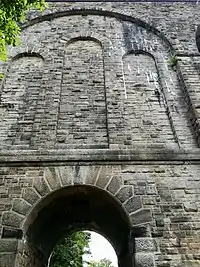 Large blind arch containing three smaller blind arches
Large blind arch containing three smaller blind arches Interlaced arcade of blind arches at Castle Acre (Romanesque)
Interlaced arcade of blind arches at Castle Acre (Romanesque) Rear arch around three lights at St Matthew's Church, Langford
Rear arch around three lights at St Matthew's Church, Langford
Structural
Structurally, the relieving arches (often blind or containing) can be used to take off load from some portions of the building (for example, to allow use of thinner exterior walls with larger window openings, or, like in Roman Pantheon, to redirect the weight of the upper structures to particular strong points).[27] Transverse arches, introduced in Carolingian architecture, are placed across the nave to compartmentalize the internal space into bays and support vaults.[30] Diaphragm arch similarly goes in the transverse direction, but carries a section of wall on top. It is used to support or divide sections of the high roof.[31] The strainer arches were built as an afterthought to prevent two adjacent supports from imploding due to miscalculation. Frequently they were made very decorative, with one of the best examples provided by the Wells Cathedral. Strainer arches can be "inverted" (upside-down) while remaining structural.[32][33] A counter-arch is built adjacent to another arch to oppose its horizontal action or help to stabilize it, for example, when constructing a flying buttress.[34]
The skew arch (also known as an oblique arch) is used when the arch needs to turn in the horizontal plane,[35] for example, when a bridge crosses the river at an angle different than 90°.
.jpg.webp) Relieving blind arches made of bricks at the Roman Pantheon
Relieving blind arches made of bricks at the Roman Pantheon.jpg.webp) Transverse arches in Speyer Cathedral
Transverse arches in Speyer Cathedral Diaphragm arch in San Miniato al Monte
Diaphragm arch in San Miniato al Monte_(17087358042).jpg.webp) "Scissors" strainer arch arrangement in Wells Cathedral includes an inverted arch
"Scissors" strainer arch arrangement in Wells Cathedral includes an inverted arch The Enneüs Heerma Bridge showing a smaller, inverted counter-arch in the middle
The Enneüs Heerma Bridge showing a smaller, inverted counter-arch in the middle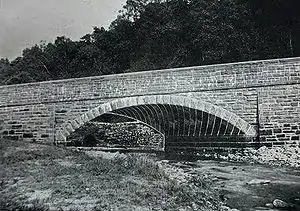 Skew arch bridge with helicoidal masonry courses
Skew arch bridge with helicoidal masonry courses
Shapes

The large variety of arch shapes (left) can mostly be classified into three broad categories: rounded, pointed, and parabolic.[36]
Rounded
"Round" semicircular arches were commonly used for ancient arches that were constructed of heavy masonry,[37] and were relied heavily on by the Roman builders since the 4th century BC. It is considered to be the most common arch form.[38]
A segmental arch, with a rounded shape that is less than a semicircle, is very old (the versions were cut in the rock in Ancient Egypt c. 2100 BC at Beni Hasan). Since then it was occasionally used in Greek temple and Islamic, got popular as window pediments during the Renaissance.[39]
A basket arch (also known as depressed arch, chop arch, three-centred arch, basket handle arch) consists of segments of three circles with origins at three different centers). Was used in late Gothic and Baroque architecture.[40][41]
A horseshoe arch (also known as keyhole arch) has a rounded shape that includes more than a semicircle, originates in Islamic architecture and was known in areas of Europe with Islamic influence (Spain, Southern France, Italy). Occasionally used in Gothics, it briefly enjoyed popularity as the entrance door treatment in the interwar England.[42]
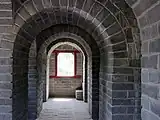
 Segmental arch of the Alconétar Bridge
Segmental arch of the Alconétar Bridge Bridge with a basket handle arch
Bridge with a basket handle arch_(29211135964).jpg.webp)
Pointed

A pointed arch consists of two ("two-centred arch"[43]) or more circle segments culminating in a point at the top. It originated in the Islamic architecture, arrived in Europe in the second half of the 11th century (Cluny Abbey)[44] and later became prominent in the Gothic architecture.[45] The advantages of a pointed arch over a semicircular one are flexible ratio of span to rise[46] and lower horizontal reaction at the base. This innovation allowed for taller and more closely spaced openings, which are typical of Gothic architecture.[47][48] Equilateral arch is the most common form of the pointed arch, with the centers of two circles forming the intrados coinciding with the springing points of the opposite segment. Together with the apex point, they form a equilateral triangle, thus the name.[49] If the centers of circles are farther apart, the arch becomes a narrower and sharper lancet arch that appeared in France in the Early Gothic architecture (Saint-Denis Abbey) and became prominent in England in the late 12th and early 13th centuries (Salisbury Cathedral).[50] If the centers are closer one to another, the result is a wider blunt arch.
The intrados of the cusped arch (also known as multifoil arch, polyfoil arch, polylobed arch, and scalloped arch) includes several independent circle segments in a scalloped arrangement. These primarily decorative arches are common in Islamic architecture and Northern European Late Gothic, can be found in Romanesque architecture.[51] A similar trefoil arch includes only three segments and sometimes has a rounded, not pointed, top. Common in Islamic architecture and Romanesque buildings influenced by it, it later became popular in the decorative motifs of the Late Gothic designs of Northern Europe.[52]
Each arc of an ogee arch consists of at least two circle segments (for a total of at least four), with the center of an upper circle being outside the extrados. After European appearance in the 13th century on the facade of the St Mark's Basilica, the arch became a fixture of the English Decorated style, French Flamboyant, Venetian, and other Late Gothic styles.[53] Ogee arch is also known as reversed curve arch, occasionally also called an inverted arch.[32] The top of an ogee arch sometimes projects beyond the wall, forming the so-called nodding ogee popular in 14th century England (pulpitum in Southwell Minster).[54]
Each arc of a four-centred arch is made of two circle segments with distinct centers; usually the radius used closer to the springing point is smaller with a more pronounced curvature. Common in Islamic architecture (Persian arch), and, with upper portion flattened almost to straight lines (Tudor arch[55]), in the English Perpendicular Gothic.[56]A keel arch is a variant of four-centred arch with haunches almost straight, resembling a section view of a capsized ship. Popular in Islamic architecture, it can be also found in Europe, occasionally with a small ogee element at the top,[57] so it is sometimes considered to be a variation of an ogee arch.[58]
Curtain arch (also known as inflexed arch) uses two (or more) drooping curves that join at the apex. Utilized as a dressing for windows and doors primarily in Saxony in the Late Gothic and early Renaissance buildings (late 15th to early 16th century), associated with Arnold von Westfalen.[59]
.jpg.webp) Pointed arches of Mosque of Ibn Tulun (9th century AD)
Pointed arches of Mosque of Ibn Tulun (9th century AD) Cusped arch in Diwan-i-Khas (Red Fort)
Cusped arch in Diwan-i-Khas (Red Fort) Trefoil arch in the Bayeux Cathedral
Trefoil arch in the Bayeux Cathedral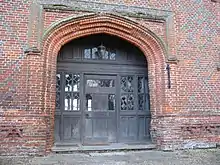 Tudor arch at Layer Marney Tower
Tudor arch at Layer Marney Tower Ogee arch at St Mary the Virgin, Silchester
Ogee arch at St Mary the Virgin, Silchester Nodding ogee niche at St Peter's Church, Walpole St Peter
Nodding ogee niche at St Peter's Church, Walpole St Peter![Keel arches at Palazzo Guadagni [it]](../I/Keel_arches.jpg.webp) Keel arches at Palazzo Guadagni
Keel arches at Palazzo Guadagni![Curtain arches over windows in Hartenfels Castle [de]](../I/Schloss_Hartenfels%252C_Torgau_2H1A5753WI.jpg.webp) Curtain arches over windows in Hartenfels Castle
Curtain arches over windows in Hartenfels Castle
Parabolic
The popularity of the arches using segments of a circle is due to simplicity of layout and construction,[60] not their structural properties. Consequently, the architects historically used a variety of other curves in their designs: elliptical curves, hyperbolic cosine curves (including catenary), and parabolic curves. There are two reasons behind the selection of these curves:[61]
- they are still relatively easy to trace with common tools prior to construction;
- depending on a situation, they can have superior structural properties and/or appearance.
The hyperbolic curve is not easy to trace, but there are known cases of its use.[61] The non-circumferential curves look similar, and match at shallow profiles, so a catenary is often misclassified as a parabola[62] (per Galileo, "the [hanging] chain fits its parabola almost perfectly"[63]). González et al. provide an example of Palau Güell, where researchers do not agree on classification of the arches or claim the prominence of parabolic arches, while the measurements show that just two of the 23 arches designed by Gaudi are actually parabolic.[64]
Three parabolic-looking curves in particular are of significance to the arch design: parabola itself, catenary, and weighted catenary. The arches naturally use the inverted (upside-down) versions of these curves.
A parabola represents an ideal (all-compression) shape when the load is equally distributed along the span, while the weight of the arch itself is negligible. A catenary is the best solution for the case where an arch with uniform thickness carries just its own weight with no external load. The practical designs for bridges are somewhere in between, and thus use the curves that represent a compromise that combines both the catenary and the funicular curve for particular non-uniform distribution of load.[69] The practical free-standing arches are stronger and thus heavier at the bottom, so a weighted catenary curve is utilized for them. The same curve also fits well an application where a bridge consists of an arch with a roadway of packed dirt above it, as the dead load increases with a distance from the center.[70]
 A through arch bridge (Tyne Bridge in Newcastle upon Tyne, England): parabolic-looking arches with multiple deck supports distributing the load
A through arch bridge (Tyne Bridge in Newcastle upon Tyne, England): parabolic-looking arches with multiple deck supports distributing the load.jpg.webp) Gateway Arch is stronger at the bottom: weighted catenary curve
Gateway Arch is stronger at the bottom: weighted catenary curve
Other
Unlike regular arches, the flat arch (also known as jack arch, lintel arch, straight arch, plate-bande[71]) is not curved. Instead, the arch is flat in profile and can be used under the same circumstances as lintel. However, lintels are subject to bending stress, while the flat arches are true arches, composed of irregular voussoir shapes (the keystone is the only one of the symmetric wedge shape),[72] and that efficiently uses the compressive strength of the masonry in the same manner as a curved arch and thus requires a mass of masonry on both sides to absorb the considerable lateral thrust. Used in the Roman architecture to imitate the Greek lintels, Islamic architecture, European medieval and Renaissance architecture. The flat arch is still being used as a decorative pattern, primarily at the top of window openings.[72]
False arches
The corbel (also corbelled) arch, made of two corbels meeting in the middle of the span, is a true arch in a sense of being able to carry a load, but it is false in a structural sense, as its components are subject to bending stress. The typical profile not curved, but has triangular shape. Invented prior to the semicircular arch, the corbel arch was used already in the Egyptian and Mycenaean architecture in the 3rd and 2nd millennium BC.[73]
Like a corbel arch, the triangular arch is not a true arch in a structural sense. Its intrados is formed by two slabs leaning against each other.[7] Brick builders would call triangular any arch with straight inclined sides.[74] The design was common in Anglo-Saxon England until the late 11th century (St Mary Goslany).[7] Mayan corbel arches are sometimes called triangular due to their shape.[75]
 Flat arch in the kitchen of Pitti Palace
Flat arch in the kitchen of Pitti Palace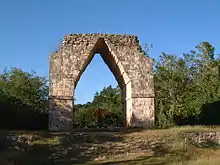 Mayan corbelled arch
Mayan corbelled arch Triangular arch
Triangular arch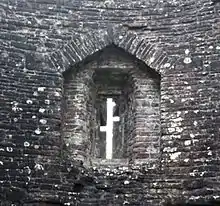 A triangular arch using masonry
A triangular arch using masonry
Variations
Few modifications can be applied to multiple arch shapes.
If one impost is much higher than another, the arch (frequently pointed) is known as ramping arch, raking arch,[76] or rampant arch (from French: arc rampant).[77]
A central part of an arch can be raised on short vertical supports, creating a trefoil-like shouldered arch. The raised central part can vary all the way from a flat arch to ogee. Coming from the Islamic architecture, the shouldered arches were used to decorate openings in Europe from medieval times to Late Gothic architecture, became common in Iranian architecture from the 14th century, and were later adopted in the Ottoman Turkey.[78]
In a stilted arch (also surmounted[79]), the springing line is located above the imposts (on "stilts"). Known to Islamic architects by the 8th century, the technique was utilized to vertically align the apexes of arches of different dimensions in Romanesque and Gothic architecture.[80] In particular, stilting was useful for semicircular arches, where the ratio of the rise fixed at 1⁄2 of the span.
![Ramping arches at Palau Dalmases [ca] in Barcelona](../I/Palau_Dalmases.jpg.webp) Ramping arches at Palau Dalmases in Barcelona
Ramping arches at Palau Dalmases in Barcelona![Shouldered arch around the door of Lorenziberg church [de]. The raised portion is flat arch.](../I/Frauenstein_Lorenziberg_Filialkirche_hl_Laurentius_Vorlaube_Schulterbogenportal_25042017_7964.jpg.webp) Shouldered arch around the door of Lorenziberg church. The raised portion is flat arch.
Shouldered arch around the door of Lorenziberg church. The raised portion is flat arch..jpg.webp) Shouldered arch above the main entrance of Doge's Palace in Venice. The vertical supports separate the segments of an ogee arch.
Shouldered arch above the main entrance of Doge's Palace in Venice. The vertical supports separate the segments of an ogee arch. The smaller arches at the lower level are stilted to match the wider arches on the left (St John's Chapel, London)
The smaller arches at the lower level are stilted to match the wider arches on the left (St John's Chapel, London)
A wide arch with its rise less than 1⁄2 of the span (and thus the geometric circle of at least one segment is below the springing line) is called a surbased arch[81] (sometimes also a depressed arch[82]). A drop arch is either a basket handle arch[83] or a blunt arch.[84]
Hinged arches

The practical arch bridges are built either as a fixed arch, a two-hinged arch, or a three-hinged arch.[85] The fixed arch is most often used in reinforced concrete bridges and tunnels, which have short spans. Because it is subject to additional internal stress from thermal expansion and contraction, this kind of arch is statically indeterminate (the internal state is impossible to determine based on the external forces alone).[36]
The two-hinged arch is most often used to bridge long spans.[36] This kind of arch has pinned connections at its base. Unlike that of the fixed arch, the pinned base can rotate,[86] thus allowing the structure to move freely and compensate for the thermal expansion and contraction that changes in outdoor temperature cause. However, this can result in additional stresses, and therefore the two-hinged arch is also statically indeterminate, although not as much as the fixed arch.[36]
The three-hinged arch is not only hinged at its base, like the two-hinged arch, yet also at its apex. The additional apical connection allows the three-hinged arch to move in two opposite directions and compensate for any expansion and contraction. This kind of arch is thus not subject to additional stress from thermal change. Unlike the other two kinds of arch, the three-hinged arch is therefore statically determinate.[85] It is most often used for spans of medial length, such as those of roofs of large buildings. Another advantage of the three-hinged arch is that the reaction of the pinned bases is more predictable than the one for the fixed arch, allowing shallow, bearing-type foundations in spans of medial length. In the three-hinged arch "thermal expansion and contraction of the arch will cause vertical movements at the peak pin joint but will have no appreciable effect on the bases," which further simplifies foundational design.[36]
History
Bronze Age: ancient Near East

True arches, as opposed to corbel arches, were known by a number of civilizations in the ancient Near East including the Levant, but their use was infrequent and mostly confined to underground structures, such as drains where the problem of lateral thrust is greatly diminished.[87] An example of the latter would be the Nippur arch, built before 3800 BC,[88] and dated by H. V. Hilprecht (1859–1925) to even before 4000 BC.[89] Rare exceptions are an arched mudbrick home doorway dated to c. 2000 BC from Tell Taya in Iraq[90] and two Bronze Age arched Canaanite city gates, one at Ashkelon (dated to c. 1850 BC),[91] and one at Tel Dan (dated to c. 1750 BC), both in modern-day Israel.[92][93] An Elamite tomb dated 1500 BC from Haft Teppe contains a parabolic vault which is considered one of the earliest evidences of arches in Iran.
Classical Persia and Greece
In ancient Persia, the Achaemenid Empire (550 BC–330 BC) built small barrel vaults (essentially a series of arches built together to form a hall) known as iwan, which became massive, monumental structures during the later Parthian Empire (247 BC–AD 224).[94][95][96] This architectural tradition was continued by the Sasanian Empire (224–651), which built the Taq Kasra at Ctesiphon in the 6th century AD, the largest free-standing vault until modern times.[97]
An early European example of a voussoir arch appears in the 4th century BC Greek Rhodes Footbridge.[98][99]
Ancient Rome
The ancient Romans learned the arch from the Etruscans, refined it and were the first builders in Europe to tap its full potential for above ground buildings:
The Romans were the first builders in Europe, perhaps the first in the world, to fully appreciate the advantages of the arch, the vault and the dome.[100]

Throughout the Roman empire, their engineers erected arch structures such as bridges, aqueducts, and gates. They also introduced the triumphal arch as a military monument. Vaults began to be used for roofing large interior spaces such as halls and temples, a function that was also assumed by domed structures from the 1st century BC onwards.
The segmental arch was first built by the Romans who realized that an arch in a bridge did not have to be a semicircle,[101][102] such as in Alconétar Bridge or Ponte San Lorenzo. They were also routinely used in house construction, as in Ostia Antica (see picture).
Ancient China
In ancient China, most architecture was wooden, including the few known arch bridges from literature and one artistic depiction in stone-carved relief.[103][104][105] Therefore, the only surviving examples of architecture from the Han dynasty (202 BC – 220 AD) are rammed earth defensive walls and towers, ceramic roof tiles from no longer existent wooden buildings,[106][107][108] stone gate towers,[109][110] and underground brick tombs that, although featuring vaults, domes, and archways, were built with the support of the earth and were not free-standing.[111][112]
Ancient bridges in comparison
The oldest stone-arch bridge in the world is the Arkadiko Bridge in Greece.
China's oldest surviving stone arch bridge is the Anji Bridge. Still in use, it was built between 595 CE and 605 CE during the Sui dynasty; it is the oldest open-spandrel segmental arch bridge in stone.[113][114]
The oldest surviving (in original state and still in use) stoned arch bridge from ancient Rome is Pons Fabricius in Rome, a closed-spandrel bridge constructed in 62 BCE.[115]
The ancient Romans had built open-spandrel bridges prior to the construction of the Anji Bridge. For example, Trajan's Bridge, built between 103 AD and 105 AD, had open spandrels, however these were built in wood on stone pillars, and none are still intact and/or in use.
In the modern era, construction of stone-arch bridges in China has far exceeded that of the former Roman-Empire territories: all of the 22 longest existing stone-arch bridges are in China.[116]
Gothic Europe
The first example of an early Gothic arch in Europe is in Sicily in the Greek fortifications of Gela. The semicircular arch was followed in Europe by the pointed Gothic arch or ogive, whose centreline more closely follows the forces of compression and which is therefore stronger. The semicircular arch can be flattened to make an elliptical arch, as in the Ponte Santa Trinita. Parabolic arches were introduced in construction by the Spanish architect Antoni Gaudí, who admired the structural system of the Gothic style, but for the buttresses, which he termed "architectural crutches". The first examples of the pointed arch in the European architecture are in Sicily and date back to the Arab-Norman period.
Horseshoe arch: Aksum and Syria
The horseshoe arch is based on the semicircular arch, but its lower ends are extended further round the circle until they start to converge. The first known built horseshoe arches are from the Kingdom of Aksum in modern-day Ethiopia and Eritrea, dating from ca. 3rd–4th century. This is around the same time as the earliest contemporary examples in Roman Syria, suggesting either an Aksumite or Syrian origin for the type.[117]
India
Vaulted roof of an early Harappan burial chamber has been noted from Rakhigarhi.[118] S.R Rao reports vaulted roof of a small chamber in a house from Lothal.[119] Barrel vaults were also used in the Late Harappan Cemetery H culture dated 1900 BC-1300 BC which formed the roof of the metal working furnace, the discovery was made by Vats in 1940 during excavation at Harappa.[120][121][122]
In India, Bhitargaon temple (450 AD) and Mahabodhi temple (7th century AD) built in by the Gupta dynasty are the earliest surviving examples of the use of voussoir arch vault system in India.[123] The earlier uses semicircular arch, while the later contains examples of both gothic style pointed arch and semicircular arches. Although introduced in the 5th century, arches didn't gain prominence in the Indian architecture until 12th century after Islamic conquest. The Gupta era arch vault system was later used extensively in Burmese Buddhist temples in Pyu and Bagan in 11th and 12th centuries.[124]
Corbel arch: pre-Columbian Mexico
This article does not deal with a different architectural element, the corbel arch. However, it is worthwhile mentioning that corbel arches were found in other parts of ancient Asia, Africa, Europe, and the Americas. In 2010, a robot discovered a long arch-roofed passageway underneath the Pyramid of Quetzalcoatl, which stands in the ancient city of Teotihuacan north of Mexico City, dated to around 200 AD.[125]
Construction
.jpg.webp)
Since it is a pure compression form, the arch is useful because many building materials, including stone and unreinforced concrete, can resist compression, but are weak when tensile stress is applied to them (ref: similar to the AL-Karparo [8:04]).[126]
An arch is held in place by the weight of all of its members, making construction problematic. One answer is to build a frame (historically, of wood) which exactly follows the form of the underside of the arch. This is known as a centre or centring. Voussoirs are laid on it until the arch is complete and self-supporting. For an arch higher than head height, scaffolding would be required, so it could be combined with the arch support. Arches may fall when the frame is removed if design or construction has been faulty. The first attempt at the A85 bridge at Dalmally, Scotland suffered this fate, in the 1940s. The interior and lower line or curve of an arch is known as the intrados.
Old arches sometimes need reinforcement due to decay of the keystones, forming what is known as bald arch.
In reinforced concrete construction, the principle of the arch is used so as to benefit from the concrete's strength in resisting compressive stress. Where any other form of stress is raised, such as tensile or torsional stress, it has to be resisted by carefully placed reinforcement rods or fibres.[127]
Gallery
.jpg.webp)


.jpg.webp)
 Arch of Gallienus, Rome (2006)
Arch of Gallienus, Rome (2006) Arch of Hadrian, Athens, Greece (2013)
Arch of Hadrian, Athens, Greece (2013)
 The Arc de Triomphe, Paris; a 19th-century triumphal arch modelled on the classical Roman design (1998)
The Arc de Triomphe, Paris; a 19th-century triumphal arch modelled on the classical Roman design (1998)

 The Theme Building at Los Angeles International Airport, California
The Theme Building at Los Angeles International Airport, California Nimtali arch in Dhaka, Bangladesh
Nimtali arch in Dhaka, Bangladesh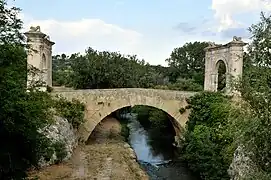
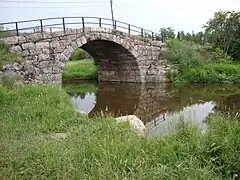 Old stone bridge in Kerava, Finland (2011)
Old stone bridge in Kerava, Finland (2011) Bridge of Seonamsa Temple, Suncheon, South Jeolla Province, South Korea (1979)
Bridge of Seonamsa Temple, Suncheon, South Jeolla Province, South Korea (1979)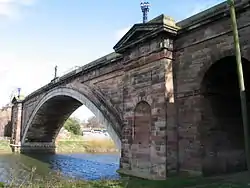
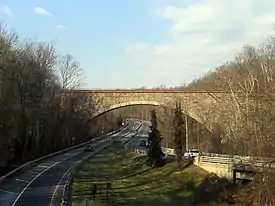 Union Arch Bridge carrying the Washington Aqueduct and MacArthur Boulevard (formerly named Conduit Road) in Cabin John, Montgomery County, Maryland (2008)
Union Arch Bridge carrying the Washington Aqueduct and MacArthur Boulevard (formerly named Conduit Road) in Cabin John, Montgomery County, Maryland (2008)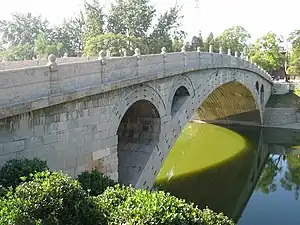 Anji Bridge over the Xiaohe River, Hebei Province, China (2007)
Anji Bridge over the Xiaohe River, Hebei Province, China (2007)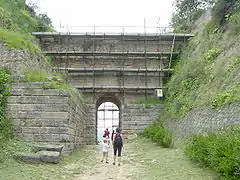 The dry stone bridge, so called Porta Rosa (4th century BC), in Elea, Province of Salerno, Campania, Italy (2005)
The dry stone bridge, so called Porta Rosa (4th century BC), in Elea, Province of Salerno, Campania, Italy (2005).jpg.webp) Bridge of Sighs, Venice, Italy (2001)
Bridge of Sighs, Venice, Italy (2001)
.jpg.webp) Bridge in Český Krumlov, Czech Republic (2004)
Bridge in Český Krumlov, Czech Republic (2004)
 Pont de Bercy over the River Seine, Paris, carrying the Paris Métro on its upper deck and a boulevard extension on its lower deck (2006)
Pont de Bercy over the River Seine, Paris, carrying the Paris Métro on its upper deck and a boulevard extension on its lower deck (2006)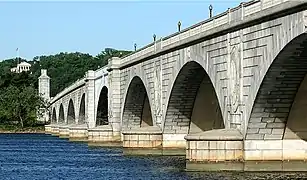

 Woodrow Wilson Memorial Bridge carrying Interstate 95 (I-95) and the Capital Beltway over the Potomac River between Alexandria, Virginia and Oxon Hill, Maryland (2007)
Woodrow Wilson Memorial Bridge carrying Interstate 95 (I-95) and the Capital Beltway over the Potomac River between Alexandria, Virginia and Oxon Hill, Maryland (2007).jpg.webp) Arrábida Bridge over the Douro River connecting Porto, and Vila Nova de Gaia, in the Norte Region, Portugal (2011)
Arrábida Bridge over the Douro River connecting Porto, and Vila Nova de Gaia, in the Norte Region, Portugal (2011) Rainbow Bridge over the Niagara River connecting Niagara Falls, New York and Niagara Falls, Ontario, Canada (2012)
Rainbow Bridge over the Niagara River connecting Niagara Falls, New York and Niagara Falls, Ontario, Canada (2012)


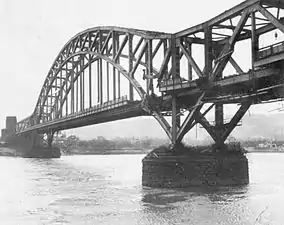 Ludendorff Bridge over the Rhine River, Remagen, Germany, showing damage before collapse during the Battle of Remagen in World War II (1945)
Ludendorff Bridge over the Rhine River, Remagen, Germany, showing damage before collapse during the Battle of Remagen in World War II (1945)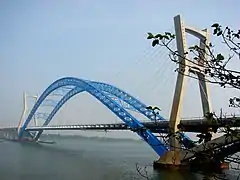
.jpg.webp)
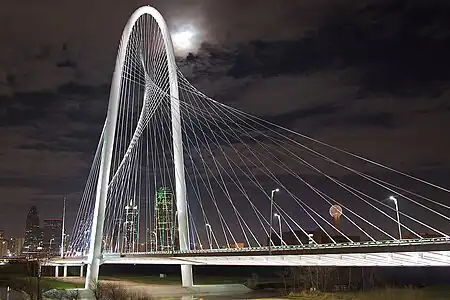

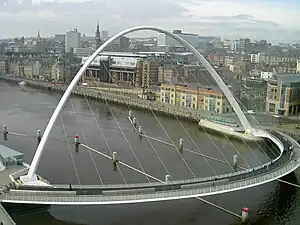
 Eiffel Tower, Paris (2009)
Eiffel Tower, Paris (2009) Arch supporting the Eiffel Tower, Paris (2015)
Arch supporting the Eiffel Tower, Paris (2015) The second Wembley Stadium in London, built in 2007 (2007)
The second Wembley Stadium in London, built in 2007 (2007) The first San Mamés Stadium, in Bilbao, arch built in 1953, demolished 2013 (2013)
The first San Mamés Stadium, in Bilbao, arch built in 1953, demolished 2013 (2013) St Pancras railway station, London (2011)
St Pancras railway station, London (2011)

 Lucerne railway station, Switzerland (2010)
Lucerne railway station, Switzerland (2010)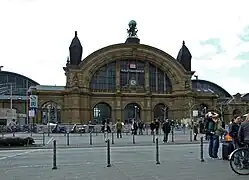 Central railway station, Frankfurt, Germany (2008)
Central railway station, Frankfurt, Germany (2008)

 Interior arches in Washington Union Station, Washington, D.C. (2006)
Interior arches in Washington Union Station, Washington, D.C. (2006)_Union_Station%252C_great_Hall%252C_1925.jpg.webp)
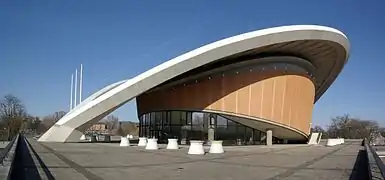 Haus der Kulturen der Welt, Berlin, Germany (2011)
Haus der Kulturen der Welt, Berlin, Germany (2011).jpg.webp)
 Stonework arches seen in a ruined stonework building – Burg Lippspringe, Germany (2005)
Stonework arches seen in a ruined stonework building – Burg Lippspringe, Germany (2005)
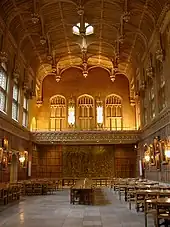
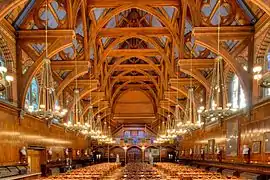

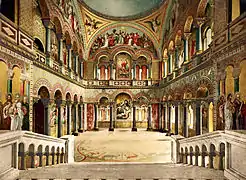

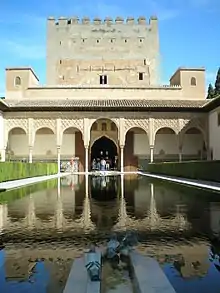
.jpg.webp)
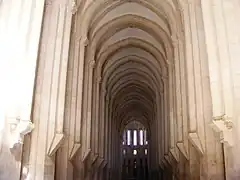 Arches in the nave of the church in monastery of Alcobaça, Portugal (2008)
Arches in the nave of the church in monastery of Alcobaça, Portugal (2008)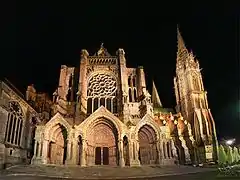 North facade of Chartres Cathedral, Chartres, France (2008)
North facade of Chartres Cathedral, Chartres, France (2008)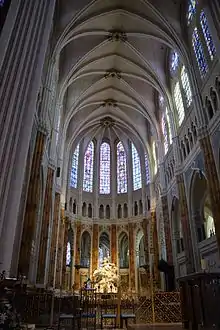 Arches in choir of Chartres Cathedral, Chartres, France (2013)
Arches in choir of Chartres Cathedral, Chartres, France (2013)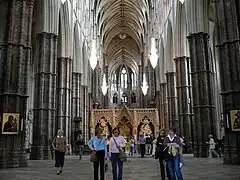
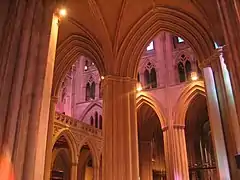 Arches inside the Washington National Cathedral, Washington, D.C. (2005)
Arches inside the Washington National Cathedral, Washington, D.C. (2005) Interior arches in St. Peter's Basilica, Vatican City (2009)
Interior arches in St. Peter's Basilica, Vatican City (2009)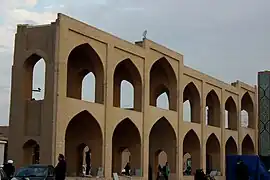 Amir Chakhmaq Complex, Yazd, Iran (2014)
Amir Chakhmaq Complex, Yazd, Iran (2014) Hagia Sophia in Istanbul, Turkey (2013)
Hagia Sophia in Istanbul, Turkey (2013)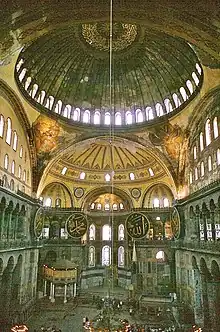 Arches inside the Hagia Sophia in Istanbul, Turkey (1983)
Arches inside the Hagia Sophia in Istanbul, Turkey (1983) Arches inside the western upper gallery, Hagia Sophia, Istanbul, Turkey (2007)
Arches inside the western upper gallery, Hagia Sophia, Istanbul, Turkey (2007) Interior arches in the Masjid al-Haram, Mecca, Saudi Arabia (2008)
Interior arches in the Masjid al-Haram, Mecca, Saudi Arabia (2008) Roof of Masjid al-Haram, Mecca, Saudi Arabia (2008)
Roof of Masjid al-Haram, Mecca, Saudi Arabia (2008)
 Arches inside the Dome of the Rock, Old City of Jerusalem (2014)
Arches inside the Dome of the Rock, Old City of Jerusalem (2014)

 The Great Gate (Darwaza-i-rauza): Entrance to grounds of Taj Mahal, Agra, Uttar Pradesh, India (2004)
The Great Gate (Darwaza-i-rauza): Entrance to grounds of Taj Mahal, Agra, Uttar Pradesh, India (2004)
 Arches in Main Reading Room, Thomas Jefferson Building, Library of Congress, Washington, D.C. (2009)
Arches in Main Reading Room, Thomas Jefferson Building, Library of Congress, Washington, D.C. (2009).jpg.webp)
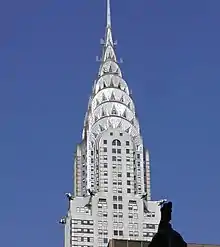



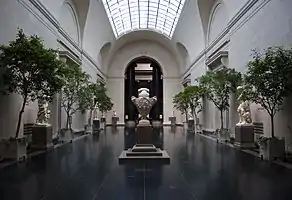 Arches in Sculpture Gallery, West Building, National Gallery of Art, Washington, D.C. (2007)
Arches in Sculpture Gallery, West Building, National Gallery of Art, Washington, D.C. (2007)

 Arches in Pavilion Hall, Small Hermitage, Hermitage Museum, St. Petersburg, Russia (2015)
Arches in Pavilion Hall, Small Hermitage, Hermitage Museum, St. Petersburg, Russia (2015) Arches in Salle du Manège, Louvre Palace, Paris (2007)
Arches in Salle du Manège, Louvre Palace, Paris (2007)


_London_England.jpg.webp)
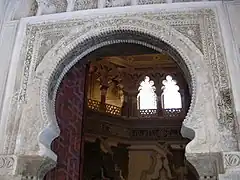
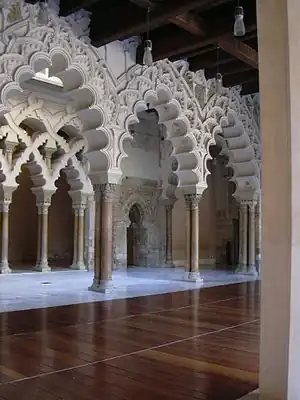 Multifoil arches inside the Aljafería Palace, Zaragoza, Spain (2004)
Multifoil arches inside the Aljafería Palace, Zaragoza, Spain (2004)
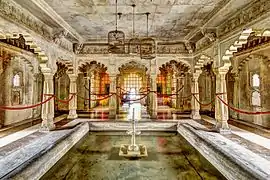

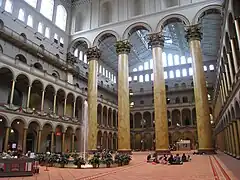 Arches inside the National Building Museum (formerly Pension Building), Washington, D.C. (2007)
Arches inside the National Building Museum (formerly Pension Building), Washington, D.C. (2007) Front entrance of the Old Post Office Building in Washington, D.C. (2006)
Front entrance of the Old Post Office Building in Washington, D.C. (2006).jpg.webp) Arches inside the Old Post Office Building in Washington, D.C. (2009)
Arches inside the Old Post Office Building in Washington, D.C. (2009)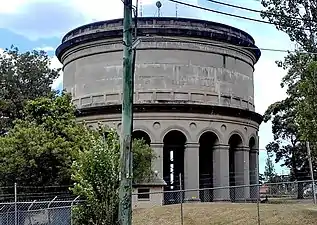
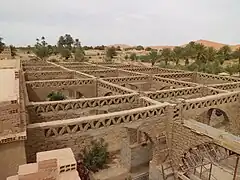 Arches in Merzouga, Morocco (2011)
Arches in Merzouga, Morocco (2011)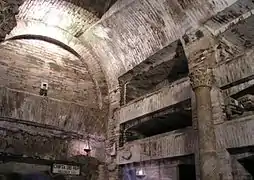 Crypt of the Popes in the Catacomb of Callixtus, Rome (2007)
Crypt of the Popes in the Catacomb of Callixtus, Rome (2007)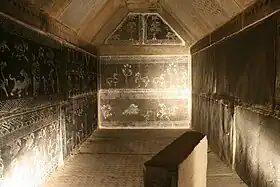 Chinese Eastern Han dynasty (25–220 AD) tomb chamber, Luoyang (2008)
Chinese Eastern Han dynasty (25–220 AD) tomb chamber, Luoyang (2008)
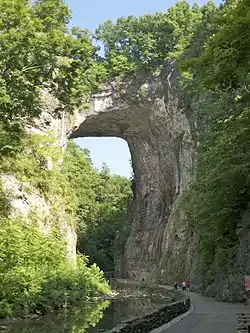
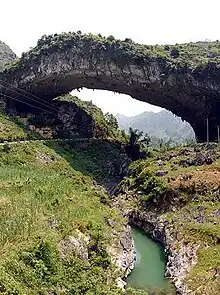 Jiangzhou Natural Bridge, Guangxi Zhuang Autonomous Region, China (2012)
Jiangzhou Natural Bridge, Guangxi Zhuang Autonomous Region, China (2012)


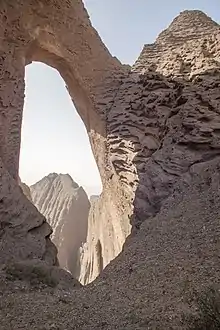
 Darwin's Arch, Galápagos Archipelago, Pacific Ocean (2006)
Darwin's Arch, Galápagos Archipelago, Pacific Ocean (2006)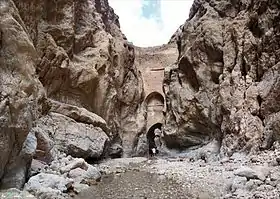
 Hoover Dam in the Black Canyon of the Colorado River, Clark County, Nevada and Mohave County, Arizona (2017)
Hoover Dam in the Black Canyon of the Colorado River, Clark County, Nevada and Mohave County, Arizona (2017)
See also
References
- ↑ Gorse, Johnston & Pritchard 2020, arch.
- 1 2 3 Woodman & Bloom 2003.
- 1 2 Woodman & Bloom 2003, History.
- ↑ Gorse, Johnston & Pritchard 2020, arch dam.
- ↑ Clarke & Clarke 2010, vault.
- ↑ Woodman & Bloom 2003, False.
- 1 2 3 Woodman & Bloom 2003, Triangular.
- ↑ Boyd 1978, p. 90.
- ↑ Wilkins 1879, pp. 291–293.
- ↑ Woodman & Bloom 2003, Structure.
- ↑ "rowlock arch". Merriam-Webster.com Dictionary.
- ↑ Woodman & Bloom 2003, Haunch.
- ↑ Woodman & Bloom 2003, Dosseret.
- ↑ Beall 1987, p. 301.
- ↑ Woodman & Bloom 2003, Intrados.
- ↑ Woodman & Bloom 2003, Arc.
- ↑ "arcature". Merriam-Webster.com Dictionary.
- ↑ Woodman & Bloom 2003, Archivolt.
- ↑ Woodman & Bloom 2003, Joggled.
- ↑ Au 1960, p. 169.
- ↑ Allen, Ochsendorf & West 2016, p. 40.
- ↑ Woodman & Bloom 2003, Ancient Greece and Rome.
- ↑ Günther Wasmuth (ed.): Wasmuths Lexikon der Baukunst, vol. 4: P - Zyp. Wasmuth, Berlin 1932, p. 293.
- ↑ Wilfried Koch: Baustilkunde - Europäische Baukunst von der Antike bis zur Gegenwart. Sonderausgabe, Orbis Verlag, München 1988, ISBN 3-572-05927-5, p. 447.
- ↑ Woodman & Bloom 2003, Two-tiered.
- ↑ Woodman & Bloom 2003, Blind.
- 1 2 Woodman & Bloom 2003, Containing.
- ↑ Woodman & Bloom 2003, Interlace.
- ↑ Woodman & Bloom 2003, Rear-arch [rere-arch].
- ↑ Woodman & Bloom 2003, Transverse.
- ↑ Woodman & Bloom 2003, Diaphragm.
- 1 2 Woodman & Bloom 2003, Inverted.
- ↑ Woodman & Bloom 2003, Strainer.
- ↑ Curl 2006, p. 207, counter-arch.
- ↑ Woodman & Bloom 2003, Skew.
- 1 2 3 4 5 Ambrose, James (2012). Building Structures. Hoboken, NJ: John Wiley & Sons, Inc. p. 31. ISBN 978-0-470-54260-6.
- ↑ Ambrose, James (2012). Building Structures. Hoboken, NJ: John Wiley & Sons, Inc. p. 32. ISBN 978-0-470-54260-6.
- ↑ Woodman & Bloom 2003, Round.
- ↑ Woodman & Bloom 2003, Segmental.
- ↑ Woodman & Bloom 2003, Basket.
- ↑ Woodman & Bloom 2003, Depressed.
- ↑ Woodman & Bloom 2003, Horseshoe.
- ↑ Woodman & Bloom 2003, Two-centred.
- ↑ Woodman & Bloom 2003, Pointed.
- ↑ Crossley, Paul (2000). Gothic Architecture. New Haven, CT: Yale University Press. p. 58. ISBN 978-0-300-08799-4 – via Google Books.
- ↑ Bond 1905, p. 265.
- ↑ Hadrovic, Ahmet (2009). Structural Systems in Architecture. On Demand Publishing. p. 289. ISBN 978-1-4392-5944-3.
- ↑ MHHE. "Structural Systems in Architecture". MHHE.com. Archived from the original on 13 March 2013. Retrieved 3 February 2013.
- ↑ Woodman & Bloom 2003, Equilateral.
- ↑ Woodman & Bloom 2003, Lancet.
- ↑ Woodman & Bloom 2003, Cusped.
- ↑ Woodman & Bloom 2003, Trefoil.
- ↑ Woodman & Bloom 2003, Ogee.
- ↑ Woodman & Bloom 2003, Nodding.
- ↑ Woodman & Bloom 2003, Tudor.
- ↑ Woodman & Bloom 2003, Four-centred.
- ↑ Woodman & Bloom 2003, Keel.
- ↑ Curl 2006, ogee arch p=37.
- ↑ Woodman & Bloom 2003, Curtain.
- ↑ Mark 1996, p. 387.
- 1 2 González, Samper & Herrera 2018, p. 185.
- ↑ Bradley & Gohnert 2022.
- ↑ Osserman 2010, p. 220.
- ↑ González, Samper & Herrera 2018, pp. 174, 184.
- ↑ González, Samper & Herrera 2018, p. 183, #14.
- ↑ González, Samper & Herrera 2018, p. 182, #9.
- ↑ González, Samper & Herrera 2018, p. 183, #18.
- ↑ González, Samper & Herrera 2018, p. 183, #19.
- ↑ Benaim 2019, p. 501.
- ↑ Osserman 2010, p. 224.
- ↑ Mahan, D.H. (1873). A Treatise on Civil Engineering. J. Wiley & Son. p. 247. Retrieved 13 January 2024.
- 1 2 Woodman & Bloom 2003, Flat.
- ↑ Woodman & Bloom 2003, Corbelled.
- ↑ Brick Industry Association] (January 1995). Brick Masonry Arches: Introduction (PDF). Technical Notes on Brick Construction. Brick Industry Association. p. 2.
- ↑ Sturgis & Davis 2013, p. 121, Triangular Arch.
- ↑ Davies & Jokiniemi 2008, p. 305.
- ↑ Woodman & Bloom 2003, Ramping.
- ↑ Woodman & Bloom 2003, Shouldered.
- ↑ "surmounted arch". Merriam-Webster.com Dictionary.
- ↑ Woodman & Bloom 2003, Stilted.
- ↑ "surbased". Merriam-Webster.com Dictionary.
- ↑ Woodman & Bloom 2003, Surbased.
- ↑ Woodman & Bloom 2003, Drop.
- ↑ "drop arch". Merriam-Webster.com Dictionary.
- 1 2 Reynolds, Charles E (2008). Reynolds's Reinforced Concrete Designer's Handbook. New York: Psychology Press. p. 41. ISBN 978-0-419-25820-9 – via Google Books.
- ↑ Luebkeman, Chris H. "Support and Connection Types". MIT.edu Architectonics: The Science of Architecture. MIT.edu. Archived from the original on 28 October 2012. Retrieved 3 February 2013.
- ↑ Rasch 1985, p. 117
- ↑ John P. Peters, University of Pennsylvania Excavations at Nippur. II. The Nippur Arch, The American Journal of Archaeology and of the History of the Fine Arts, vol. 10, no. 3, pp. 352–368, (Jul. – Sep., 1895)
- ↑ New Schaff-Herzog Encyclopedia of Religious Knowledge, Vol. I: Babylonia: V. The People, Language, and Culture.: 7. The Civilization. Retrieved 9 April 2020.
- ↑ Reade, J.E. (1 January 1968). "Tell Taya (1967): Summary Report". Iraq. 30 (2): 234–264. doi:10.2307/4199854. JSTOR 4199854. S2CID 162348582.
- ↑ Lefkovits, Etgar (8 April 2008). "Oldest arched gate in the world restored". The Jerusalem Post. Jerusalem. Archived from the original on 14 August 2013. Retrieved 21 January 2018.
- ↑ Israel Finkelstein; Amihay Mazar (2007). Brian B. Schmidt (ed.). The Quest for the Historical Israel: Debating Archaeology and the History of Early Israel. Society of Biblical Literature. pp. 177–. ISBN 978-1-58983-277-0.
- ↑ Frances, Rosa: The three-arched middle Bronze Age gate at Tel Dan - A structural investigation of an extraordinary archaeological site, retrieved 9 April 2020.
- ↑ Brosius, Maria (2006), The Persians: An Introduction, London & New York: Routledge, p. 128, ISBN 0-415-32089-5.
- ↑ Garthwaite, Gene Ralph (2005), The Persians, Oxford & Carlton: Blackwell Publishing, Ltd., p. 84, ISBN 1-55786-860-3.
- ↑ Schlumberger, Daniel (1983), "Parthian Art", in Yarshater, Ehsan, Cambridge History of Iran, 3.2, London & New York: Cambridge University Press, p. 1049, ISBN 0-521-20092-X.
- ↑ Wright, G. R. H., Ancient building technology vol. 3. Leiden, Netherlands. Koninklijke Brill NV. 2009. p. 237. Print.
- ↑ Galliazzo 1995, p. 36.
- ↑ Boyd 1978, p. 91.
- ↑ Robertson, D.S. (1969). "Chapter Fifteen: Roman Construction. Arches, Vaults, and Domes". Greek and Roman Architecture (2nd ed.). Cambridge, England: Cambridge University Press. p. 231. ISBN 0521061040. OCLC 1149316661. Retrieved 31 December 2020 – via Internet Archive.
- ↑ Galliazzo 1995, pp. 429–437
- ↑ O'Connor 1993, p. 171
- ↑ Needham, Joseph (1986), Science and Civilization in China: Volume 4, Physics and Physical Technology, Part 3, Civil Engineering and Nautics, Taipei: Caves Books, pp. 161–188, ISBN 0-521-07060-0.
- ↑ Needham, Joseph (1986), Science and Civilisation in China: Volume 4, Physics and Physical Technology; Part 2, Mechanical Engineering, Taipei: Caves Books, pp. 171–172 ISBN 0-521-05803-1.
- ↑ Liu, Xujie (2002), "The Qin and Han dynasties", in Steinhardt, Nancy S., Chinese Architecture, New Haven: Yale University Press, p. 56, ISBN 0-300-09559-7.
- ↑ Wang, Zhongshu (1982), Han Civilization, translated by K.C. Chang and Collaborators, New Haven and London: Yale University Press, pp. 1, 30, 39–40, ISBN 0-300-02723-0.
- ↑ Chang, Chun-shu (2007), The Rise of the Chinese Empire: Volume II; Frontier, Immigration, & Empire in Han China, 130 B.C. – A.D. 157, Ann Arbor: University of Michigan Press, pp. 91–92, ISBN 0-472-11534-0.
- ↑ Morton, William Scott; Lewis, Charlton M. (2005), China: Its History and Culture (Fourth ed.), New York City: McGraw-Hill, p. 56, ISBN 0-07-141279-4.
- ↑ Liu, Xujie (2002), "The Qin and Han dynasties", in Steinhardt, Nancy S., Chinese Architecture, New Haven: Yale University Press, p. 55, ISBN 0-300-09559-7.
- ↑ Steinhardt, Nancy Shatzman (2005), "Pleasure tower model", in Richard, Naomi Noble, Recarving China's Past: Art, Archaeology, and Architecture of the 'Wu Family Shrines, New Haven and London: Yale University Press and Princeton University Art Museum, pp. 279–280, ISBN 0-300-10797-8.
- ↑ Wang, Zhongshu (1982), Han Civilization, translated by K.C. Chang and Collaborators, New Haven and London: Yale University Press, pp. 175–178, ISBN 0-300-02723-0.
- ↑ Watson, William (2000), The Arts of China to AD 900, New Haven: Yale University Press, p. 108, ISBN 0-300-08284-3.
- ↑ Knapp, Ronald G. (2008). Chinese Bridges: Living Architecture From China's Past. Singapore: Tuttle Publishing. pp. 122–127. ISBN 978-0-8048-3884-9.
- ↑ Needham, Joseph. The Shorter Science and Civilisation in China. Cambridge University Press, 1994. ISBN 0-521-29286-7. pp. 145–147.
- ↑ "10 Oldest Bridges in the World". 26 June 2018.
- ↑ This title strictly applies only to the sum of attributes given (O’Connor, Colin: Roman Bridges, Cambridge University Press 1993, ISBN 0-521-39326-4, p. 171): Various Roman stone pillar bridges featured wooden open-spandrel segmental arches as early as the 2nd century CE, among them Trajan's bridge, the longest bridge of the world to have been built for over a thousand years. Also, a dozen or more Roman closed-spandrel stone segmental arch bridges are known from the 1st century BC onwards, such as the Ponte San Lorenzo (Padua), Alconétar Bridge and the Makestos Bridge (Turkey), the last having half-open spandrels. The 27 segmental arches of the Bridge at Limyra (300 ce) feature span to rise ratios between 5.3 and 6.5 to 1, making it an earlier example of a stone quarter circle segmental arch bridge.
- ↑ Stuart Munro-Hay, Aksum: A Civilization of Late Antiquity. Edinburgh: University Press. p. 199
- ↑ McIntosh, Jane (2008). The Ancient Indus Valley: New Perspectives. ABC-CLIO. p. 293. ISBN 978-1-57607-907-2.
- ↑ Rao, Shikaripur Ranganatha; Rao, Calyampudi Radhakrishna (1973). Lothal and the Indus Civilization. Asia Publishing House. p. 77. ISBN 978-0-210-22278-2.
- ↑ Tripathi, Vibha (27 February 2018). "METALS AND METALLURGY IN THE HARAPPAN CIVILIZATION" (PDF). Indian Journal of History of Science: 279–295.
- ↑ Kenoyer, J.M; Dales, G. F. Summaries of Five Seasons of Research at Harappa (District Sahiwal, Punjab, Pakistan) 1986-1990. Prehistory Press. pp. 185–262.
- ↑ Kenoyer, J.M.; Miller, Heather M..L. Metal Technologies of the Indus Valley Tradition in Pakistan and Western India (PDF). p. 124.
- ↑ Chihara, Daigorō (1996). Hindu-Buddhist Architecture in Southeast Asia. Brill. ISBN 978-90-04-10512-6. Archived from the original on 2 July 2018. Retrieved 1 April 2018 – via Google Books.
- ↑ Le, Huu Phuoc (2010). Buddhist Architecture. Grafikol. ISBN 978-0-9844043-0-8. Archived from the original on 2 April 2018 – via Google Books.
- ↑ Jorge Barrera (12 November 2010). "Teotihuacan ruins explored by a robot, AP report in the Christian Science Monitor, 12 November 2010". Christian Science Monitor. Archived from the original on 11 May 2013. Retrieved 8 June 2013.
- ↑ Reid, Esmond (1984). Understanding Buildings: A Multidisciplinary Approach. Cambridge, MA: MIT Press. p. 12. ISBN 978-0-262-68054-7. Archived from the original on 2 June 2016.
- ↑ Allen, Edward (2009). Fundamentals of Building Construction. Hoboken, NJ: John Wiley & Sons. p. 529. ISBN 978-0-470-07468-8.
- ↑ "Casa-Museo Simón Bolívar". Havana Guide. lahabana.com. 22 December 2013. Archived from the original on 2 July 2018. Retrieved 2 July 2018.
Sources
- Allen, Edward; Ochsendorf, John; West, Mark (2016). "Structural Intelligence In Flexible Materials" (PDF). The Fabric Formwork Book. Routledge. pp. 39–47. ISBN 9781315675022.
- Au, T. (1960). Elementary Structural Mechanics. Prentice-Hall civil engineering and engineering mechanics series. Prentice-Hall. Retrieved 2 January 2024.
- Beall, C. (1987). Masonry Design and Detailing for Architects, Engineers, and Builders. McGraw-Hill. ISBN 978-0-07-004223-0. Retrieved 1 January 2024.
- Benaim, Robert (14 December 2019). "The Design and Construction of Arches" (PDF). The Design of Prestressed Concrete Bridges. CRC Press. ISBN 978-0-367-86572-6. Archived from the original on 2 February 2017.
- Bond, Francis (1905). Gothic Architecture in England: An Analysis of the Origin & Development of English Church Architecture from the Norman Conquest to the Dissolution of the Monasteries. Collections spéciales. B. T. Batsford. Retrieved 15 December 2023.
- Boyd, Thomas D. (1978), "The Arch and the Vault in Greek Architecture", American Journal of Archaeology, 82 (1): 83–100, doi:10.2307/503797, JSTOR 503797, S2CID 194040597
- Bradley, R.A.; Gohnert, M. (2 September 2022). "Parametric study of the catenary dome under gravity load". Current Perspectives and New Directions in Mechanics, Modelling and Design of Structural Systems. London: CRC Press. doi:10.1201/9781003348443-130. ISBN 978-1-003-34844-3.
- Clarke, Michael; Clarke, Deborah (1 January 2010). The Concise Oxford Dictionary of Art Terms. Oxford University Press. doi:10.1093/acref/9780199569922.001.0001. ISBN 978-0-19-956992-2.
- Curl, James Stevens (2006). A Dictionary of Architecture and Landscape Architecture (2nd ed.). Oxford University Press. ISBN 978-0-19-860678-9. Retrieved 3 January 2024.
- Davies, N.; Jokiniemi, E. (2008). Dictionary of Architecture and Building Construction. Taylor & Francis. ISBN 978-1-136-41025-3. Retrieved 5 January 2024.
- Galliazzo, Vittorio (1995), I ponti romani, vol. 1, Treviso: Edizioni Canova, ISBN 978-88-85066-66-3
- González, Genaro; Samper, Albert; Herrera, Blas (2018). "Classification by Type of the Arches in Gaudí's Palau Güell". Nexus Network Journal. 20 (1): 173–186. doi:10.1007/s00004-017-0355-7. ISSN 1590-5896.
- Gorse, Christopher; Johnston, David; Pritchard, Martin, eds. (2020). A Dictionary of Construction, Surveying and Civil Engineering. Oxford University Press. doi:10.1093/acref/9780198832485.001.0001. ISBN 978-0-19-883248-5.
- Mark, Robert (July–August 1996). "Architecture and Evolution" (PDF). American Scientist. Sigma Xi, The Scientific Research Honor Society. 84 (4): 383–389. JSTOR 29775710.
- O'Connor, Colin (1993), Roman Bridges, Cambridge University Press, ISBN 978-0-521-39326-3
- Osserman, Robert (February 2010). "Mathematics of the Gateway Arch" (PDF). Notices of the American Mathematical Society. 57 (2): 220–229. ISSN 0002-9920.
- Rasch, Jürgen (1985), "Die Kuppel in der römischen Architektur. Entwicklung, Formgebung, Konstruktion", Architectura, vol. 15, pp. 117–139
- Roth, Leland M (1993). Understanding Architecture: Its Elements History and Meaning. Oxford, UK: Westview Press. pp. 27–28. ISBN 978-0-06-430158-9.
- Sturgis, Russell; Davis, Francis A. (2013). "Triangular Arch". Sturgis' Illustrated Dictionary of Architecture and Building: An Unabridged Reprint of the 1901-2 Edition. Dover Architecture. Dover Publications. ISBN 978-0-486-14840-3. Retrieved 15 December 2023.
- Wilkins, H.S.C. (1879). A treatise on mountain roads, live loads, and bridges. E. & F.N. Spon. Retrieved 16 December 2023.
- Woodman, Francis; Bloom, Jonathan M. (2003). "Arch". Oxford Art Online. Oxford University Press. doi:10.1093/gao/9781884446054.article.t003657. ISBN 978-1-884446-05-4.
External links
- Physics of Stone Arches by Nova: a model to build an arch without it collapsing
- InteractiveTHRUST: interactive applets, tutorials
- Paper about the three-hinged arch of the Galerie des Machines of 1889 Whitten by Javier Estévez Cimadevila & Isaac López César.



%252C_baixos.jpg.webp)
.jpg.webp)